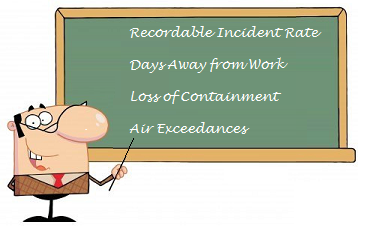RL Blogs

By Steve Pagani
Jun 07, 2015Does your refinery management struggle with communicating safety expectations? |
||
|
Safety, Health, and Environment are 3 words that first come to mind when people think about refinery “safety”. As these 3 descriptors are likely in the department name, many companies have even changed the ordering of these words to message the proper focus areas.
In my opinion it does not matter if your refinery calls it the SHE, EHS, or HES department. What really matters is how you communicate the goals of each area.
Everyone in the oil industry should be familiar with key performance metrics such as:
While industry has advanced significantly over the past couple of decades in both performance and safety culture, many companies still struggle with setting and messaging their safety culture.
For example, how can anyone feel comfortable with measuring number of fatalities as a metric? Does your company even set a target that is not Zero?
The reality is that zero is a non-attainable number for many of the categories listed above. Most leaders are comfortable with setting non-Zero targets for many or all of the performance metrics; however, there’s often uncertainty in where to draw the line.
The struggle lies in balancing performance improvement with establishing and communicating the appropriate targets. This ultimately defines a refinery’s culture.
Leadership influences on refinery safety programs have been previously discussed, but I’d like to drill deeper on some intricacies. What many people often underestimate is the power of subconscious influence.
It is easy to identify disconnects between leadership actions and advocacy when obvious examples appear. We also understand the consequences of these disconnects. However, few people understand the cause and effect of subtle changes in messaging and expectation setting.
For illustration I’ll compare two hypothetical leadership teams. On one side there is the refinery management team that vocally supports reliability, but is not willing to spend money for necessary repairs.
This team also preaches about personnel safety, but promote short-cuts to get work done quicker. In this scenario no one is fooled, and the poor integrity of refinery leadership cascades to all other performance areas such as environmental exceedances and process safety.
On the flip side of the coin, let’s take a refinery leadership team that demonstrates good alignment between goals and actions. Managers of this second refinery uphold strong safety standards and are routinely engaged with the workforce by walking the field on a frequent basis.
In this second scenario, employees follow leadership behaviors and demonstrate good safety culture. Safety messages are frequently communicated through the organization, and risky behaviors are often challenged and eliminated.
This second refinery has better safety performance than the first, and actually ranks within the top half of industry peers. That being said, should this management team accept “better than peer” performance, or should they strive to do better? People and environment are still at risk, and injuries and incidents still occur.
Industry leaders who have finally turned the corner have stopped valuing safety performance as a necessity to run a good business, but an imperative to operate as a morally responsible company.
This responsibility applies not only to employee safety and health, but also to environmental conservation. In order to lead an entire organization to the highest performance, refinery management needs to step expectations to the next level.
“stop valuing safety performance as a necessity
to run a good business, but an imperative to
operate as a morally responsible company.”
So what does it mean to step expectations to the next level?
It means to stop comparing yourselves to historic performance and peers and to start striving to attain performance beyond best in class. The beauty of this concept is that any refinery can reach this point regardless of starting point.
It’s a mentality, not a metric.
Take any refinery safety or environmental metric and challenge the bounds. Do not set targets based on historic data normalized for refinery size and complexity.
Set targets based on how you want to define your organization. What do you expect to happen the next time you update your refinery scorecard and reduce LTIR to half the prior year target?
What if you held people accountable to that target? I would venture to guess that loss time injury rates would decline if you made this an expectation instead of a desire.
Beyond the consistency of safety culture messaging, the actual message makes a significant difference. These are rather intuitive concepts that no one will disagree with.
So what’s preventing refinery leaders from succeeding here? | ||
|
|


.jpg)







